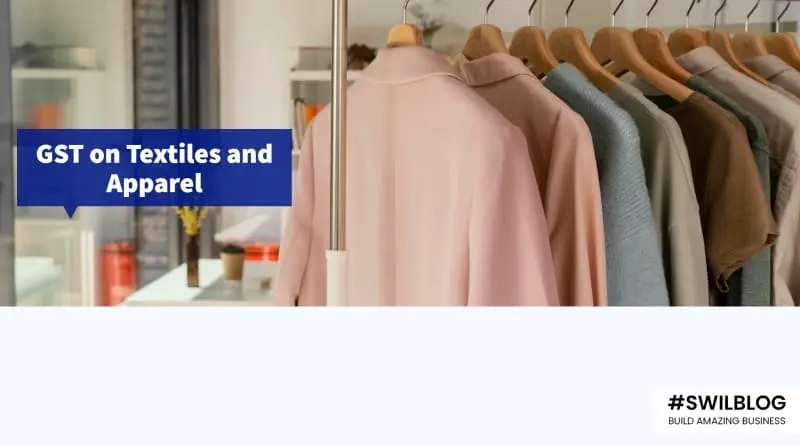Regarding GDP, employment, and export promotion, India’s garment industry ranks among the oldest and largest contributors to the country’s economic expansion. The textile industry, one of the nation’s oldest and second-largest manufacturing sectors, employs skilled and unskilled workers. Therefore, businesses must be aware of the GST on apparel, clothing, and textile goods.
- The Goods and Services Tax: What is It?
- HSN Code and GST rate for clothing
- What is the textile and textile-related GST rate?
- The following are the textile goods and products that are included in the HSN code’s chapter 63 list
- Frequently Asked Questions
- Conclusion
The Goods and Services Tax: What is It?
On July 1, 2017, the Goods and Services Tax (or GST), a more straightforward tax payment method, was implemented. It is imposed on all parties involved in the supply of goods and services in the nation. To achieve uniformity in the indirect tax structure, service taxes, excise taxes, and other taxes that were in place before the implementation of the GST have been repealed.
Businesses are required to collect this indirect tax when providing goods or services. Each business applies to GST Registration and receives a unique GSTIN based on eligibility.
HSN Code and GST rate for clothing
The HSN code’s Chapter 61 covers knitted and worn clothing. Clothing that is not knitted is covered in Chapter 62.
The garment industry cannot claim the input tax credit because the GST rate on raw materials is higher than the GST rate on finished goods. The Indian government changed the GST on clothing in January 2022 to address this issue; however, these changes have not yet been implemented.
From January 2022, it was proposed to raise the clothing GST rates from 5% to 12%. The problems caused by inverted duty structures, which affect a portion of the textile value chain, necessitate raising the clothing GST rate. However, the industry did not welcome the change, so the new rate was not announced.
Regardless of value, the GST rates for clothing as a whole were to be set at 12% beginning in January 2022. This indicates that the GST rate for clothing of any value—below Rs.1,000 or above—is 12%, as opposed to the previous GST rate of 5% for clothing priced up to Rs.1,000. The GST rate on textiles, such as rugs, synthetic yarn, woven fabrics, pile fabrics, blankets, and accessories like tablecloths, serviettes, or tapestries, would go up from 5% to 12%.
However, the same has yet to be announced, so the lower value slab of Rs.1,000 or less will continue to be subject to the current rate of 5% until then. Furthermore, garments valued above Rs.1,000 are subject to a 12% GST.
The HSN code 9988 applies a 5% GST rate to tailoring services. The prices for renting clothes are the same as those above.
What is the textile and textile-related GST rate?
Under the headings “other made-up textile articles, sets, worn apparel and worn textile articles,” Chapter 63 of the HSN code lists various textile products. Rags,” which include bedsheets, curtains, secondhand clothing, and other textiles.
The goods’ sale price will determine the tax rate for this section.
- If a textile item is sold for less than 1,000 yen, the GST rate is 5%.
- If the sale price is more than 1,000, the GST rate is 12%.
The following are the textile goods and products that are included in the HSN code’s chapter 63 list:
- Drapes, bed valances, and interior blinds and curtains.
- Typically, terry toweling or other related terry textiles are used to make kitchen and bathroom towels, as well as knitted or crocheted bed sheets.
- Tablecloths, table covers, napkins, pillowcases, counterpanes, and bed sheets are all examples of additional furnishings or decorative items. Travel carpets and blankets, in addition to terry towels, mosquito nets, and cushion covers.
- For product packaging, the same kind of bags and sacks are utilized.
Under both sections, each article of clothing or garment will be subject to a 5% GST on Textile Product tax if the taxable value of the products does not exceed 1000 per unit. Similarly, a 12% GST rate applies to all clothing and apparel with a market price of more than 1,000 yen. If the cost of apparel and footwear is less than 1,000, a 5% GST rate is applied, while the standard GST rate for textile products is 12%.
Frequently Asked Questions
1. What are the four GST types?
The Central Goods and Services Tax, the State Goods and Services Tax, the Union Territory Goods and Services Tax, and the Integrated Goods and Services Tax are the various forms of GST in India.
2. What are the fundamental GST rules?
to anyone who provides goods and/or services worth more than Rs 20 lakh per fiscal year. For some states in the special category, the limit is Rs 10 lakh. registration is required for these. Additionally, when revenue exceeds Rs 20 lakh (or Rs 10 lakh for some special category states), GST must be paid.
3. Which three pillars of GST are they?
The three pillars of the goods and services tax (GST) are CGST, SGST, and IGST. The Goods and Service Tax, also known as the GST, is an indirect tax that took effect on July 1, 2017. Under the slogan “One Nation, One Tax,” GST was implemented in India to eliminate the hassle of multiple taxes.
4. What is the GST minimum amount?
A company is required to register with the Goods and Services Tax if its annual revenue exceeds Rs 20 lakh.
5. Is clothing subject to GST?
Clothes are subject to GST.
6. What are the rates of the Goods and Services Tax (GST) that apply to clothing—whether it
is ready-made or stitched clothing?
Ready-made and stitched clothing are subject to a 5% GST rate
7. The GST rate for tailoring services is what?
The GST Council decided to reduce the rate from 18% to 5% for tailoring services.
8. In India, how much is the GST on clothing?
Depending on the value, the clothing GST ranges from 5% to 12%.
Conclusion
SWIL has been the most prominent solution provider in the retail and distribution industry. SWIL has specialized in software solutions for the healthcare and retail sectors, asset tracking, and effectively serving wholesalers and retailers of all sizes in India and worldwide.








